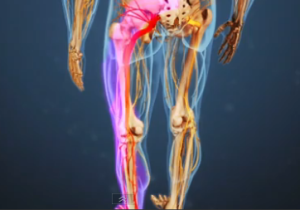Sciatica is one of the most common forms of lower back and leg pain.
While Sciatica is not a medical diagnosis, it is a symptom of an
 underlying problem in the lower back (such as a herniated disc or spinal stenosis that is compressing or irritating the nerve roots).
underlying problem in the lower back (such as a herniated disc or spinal stenosis that is compressing or irritating the nerve roots).
This is an important distinction because it is the underling diagnosis (versus the symptoms of sciatica) that needs to be treated in order to relieve the leg pain.
Sciatica is a term that describes symptoms of pain, numbness, and/or weakness that radiate along the sciatic nerve from the lower back to the buttocks and leg. The medical term for sciatica is lumbar radiculopathy.
The vast majority of sciatica symptoms result from lower back disorders between the L4 and S1 levels that put pressure on or cause irritation to a lumbar nerve root.
Most commonly, sciatica is caused by a disc problem, such as a herniated disc that is pressing against a nerve root.
Pain can also occur when a disc degenerates, which releases inflammatory proteins that irritate the adjacent nerve. There are many additional causes of sciatica.
Sciatica symptoms are typically felt on only one side of the body. They may include a combination of leg and foot pain, weakness, tingling or numbness.
Sciatica pain is often described as searing or sharp, as opposed to achy or throbbing.
Depending on where the sciatic nerve roots are compressed, symptoms may be felt in different areas of the leg and into the foot.
Treatment aims at finding the source of the pain, and improving the function of the damaged area, so that the nerve irritation and compression is reduced, which in turn decreases your lower back and leg pain.







